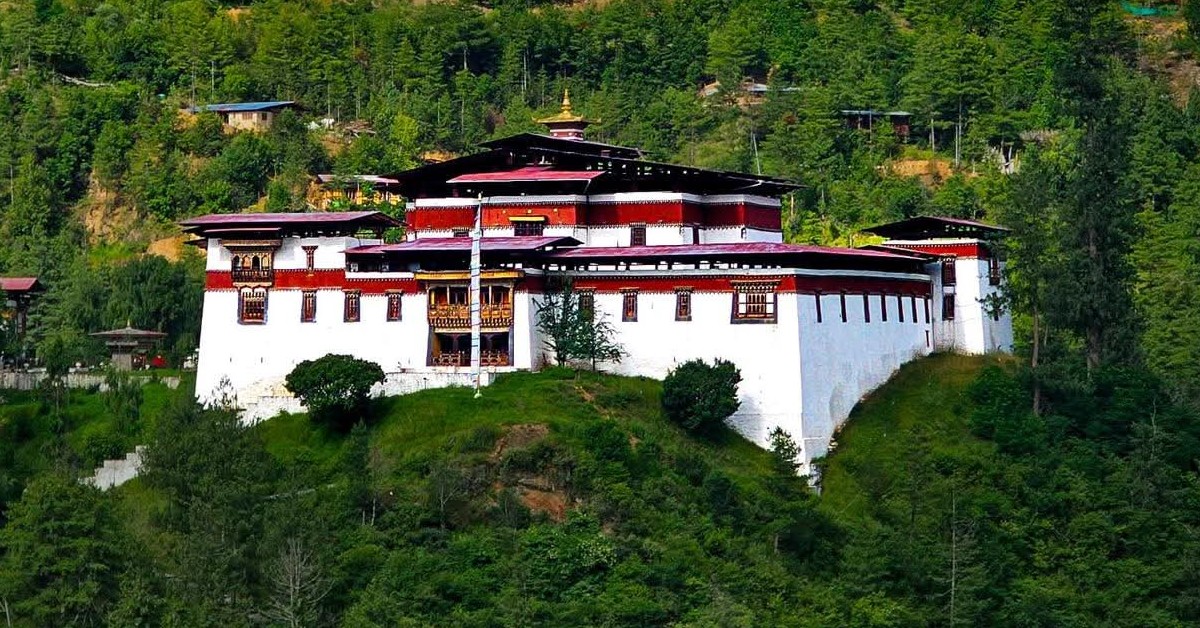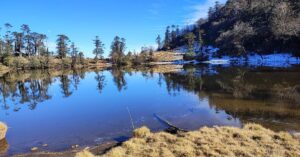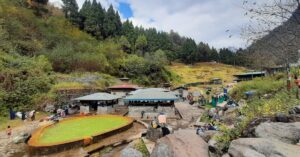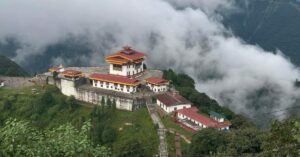Simtokha Dzong, also known as Sangak Zabdhon Phodrang, ‘Palace of the Profound Meaning of Secret Mantras’, is the first dzong built by the Zhabdrung Ngawang Namgyal in Bhutan. It was built in 1629 at the junction of Sha, Wang, and Pa Sum to fulfill the prophecy and subdue a demoness harming the people.
The strategic location of the dzong on a projecting ridge protected the Thimphu valley. It controlled the passage from western Bhutan via the Dochu La Pass to the east, while serving as an administrative and religious center.
Today, it is an important historical monument and a Buddhist monastery that laid the foundational principle for the construction of subsequent dzongs that we see in Bhutan.
How to Reach Simtokha Dzong
Simtokha Dzong was connected to the road in 1984. It is located about 5 kilometers south of Thimphu, along the old road to Paro and Phuentsholing. It’s a short 10 to 20-minute drive from Thimphu city via the Simtokha-Thimphu highway or Babesa-Thimphu Expressway. When you reach the junction to Chamgang on the Simtokha-Thimphu highway, there is a Chorten that dates back to Zhabdrung’s time. Drive on this road and turn right, which will lead you to Simtokha Dzong.
History of Simtokha Dzong
Simtokha Dzong is the oldest Dzong built by Zhabdrung Rinpoche in Bhutan.
According to the history of Simtokha Dzong, a Tibetan Lama named Zhang prophesied that Zhabdrung Ngawang Namgyel would build a dzong at the boundary of the three western lands: Sha (Wangduephodrang), Wang (Thimphu), and Pa (Paro). The junction was marked with three stones surrounding a temple built on a piece of land known as Semtokha or Sem-dokha.
When Zhabdrung came to Bhutan, the temple was gifted to Zhabdrung by Lama Panka Song. Accordingly, to fulfill the prophecy and honor the offer of Lama Panka Song, Zhabdrung decided to build a dzong. However, the site was inhabited by a demoness who harmed travelers. Zhabdrung subdued the demoness, banishing her into the rock, and he laid the foundation of the dzong in 1629, corresponding to the 11th Rabjung and Earth-Snake Year of the Bhutanese calendar.
The Dzong was modelled on the Gyal Gyad Tshel Institute of Ralung. Tango Choje Mipham Tshewang Tenzin, with assistance from Zhab-drung’s devotees and disciples, completed the dzong in 1631, corresponding to the Iron Sheep Year of the Bhutanese calendar. Coinciding with the birth of Gyalse Jampel Dorji, Zhabdrung’s son from his consort, Thricham Golkar Dolma, the dzong was consecrated by Yongzin Khay Wang Lhawang Lodroe. The dzong was named Sanga Zabdon Phodrang, the Palace of the profound meaning of secret mantras.
Later, the dzong derived its name, Simtokha Dzong, from the word sinmo (demoness), do (stomach/rock), and kha (on), meaning the dzong on “top of the demon’s stomach or a rock that buried the demoness”.
Tibetan Invasion of Simtokha Dzong
Simtokha Dzong was attacked by an alliance of Tibetans and five Bhutanese lamas from rival Buddhist schools who opposed the Zhabdrung’s rule during its construction in 1629. The attack was, however, repelled with the killing of Palden Lama, the leader of the coalition. The Tibetans attacked again in 1630 and took the dzong, but Zhabdrung regained control when the main building caught fire and the roof collapsed, killing the invaders. The dzong was restored and finally completed in 1631.
Renovation of Simtokha Fortress Dzong
The first renovation of Simtokha Dzong was completed under the supervision of the third Druk Desi Chogyal Minjur Tenpa in 1671. He expanded the dzong and replaced all the old wooden blocks, then had it consecrated by Gyalsay Tenzin Rabgye. In 1970, minor renovation work was carried out. In 2002, the government initiated a major renovation of the dzong. The most recent restoration was carried out by Japanese architects on the murals within the fortress.
Significance of Simtokha Dzong
Simtokha Dzong holds great significance as the first dzong in Bhutan, constructed in 1629 by the Zhabdrung Ngawang Namgyal, which combined both religious and administrative functions, marking the foundation of Bhutan’s dzong system and unified defense and governance.
The dzong exemplifies early Bhutanese fortress architecture, characterized by its large stone walls and intricate murals and sculptures, including statues of various Buddhist deities. It symbolizes Bhutan’s cultural identity, religious heritage, and historical resilience, having withstood invasions and survived many centuries largely intact.
Simtokha Dzong also holds special significance in housing the first-ever inner sanctum of the largest statue of the deity Yeshey Gonpo, the protector deity of Bhutan.
The scriptures of the Kanjur (Translation of the words of the Buddha) and the Bum (Prajnaparamita), which are considered unique and special, are among the precious items of the dzong. These texts were written by the 2nd Desi, La Ngonpa Tenzin Drugda, in 1656 and completed in full by the 4th Desi, Tenzin Rabgye, in 1674.
Description of Simtokha Dzong Complex
The main relic of Simtokha Dzong is the statue of the Buddha Shakya Gyalpo.
Simtokha Dzong is a squat, whitewashed fortress built over 65 square meters with a single entry point from the south. The dzong is roughly one-quarter the size of the Punakha Dzong, the second-largest dzong, which was built a decade later.
As you enter the dzong, notice the murals of the four guardian kings – Vaishravana (north), Dhritarashtra (east), Virudhaka (south), and Virupaksha (west) – guarding the four directions, and the jewel-spitting mongoose in the hand of the yellow King of the North.
The Utse (central tower) is three stories high and has twelve sides, which makes it a dodecahedron, unlike any other dzong in Bhutan. It is built in the rough shape of a mandala, with row upon row of prayer wheels meandering around its base, backed by more than 300 slate carvings depicting saints and philosophers.
The main Lhakhang in the central tower features a statue of Sakyamuni Buddha, flanked by the eight bodhisattvas, and the ceiling is adorned with an incredible array of dhvaja (victory banners) in brightly colored silk. It is believed that fortunate visitors can see a light emitting from this Sakyamuni Buddha statue.
In the western shrine are statues of Chenrezig, the wives of the Tibetan King Songtsen Gampo, and the green and white Taras. You can also see an old painting depicting Zhabdrung Ngawang Namgyal. The eastern goenkhang is dedicated to the Yeshe Goenpo and Pelden Lhamo, the protector deities of Bhutan. Take a look at the tigers’ tails and guns hanging from the pillars.
The Present State
The dzong today houses the head Lama’s chamber, a chamber to store all weapons, a storeroom, and the monastic school. The current main entrance of the dzong was moved from the east gate to the old secret gate at the south. A new conference hall was constructed after the main entrance gate was relocated. A guest house was built on the site, which had previously been used as a stable.
One can see the ruins of the Ta Dzong (watch tower) just 500 meters above the dzong. To the left, approximately 100 meters away, is a Chu Dzong (water fortress), which is now used as a prayer hall by the students.
Best Time to Visit Simtokha Dzong
There is no best time to visit Simtokha Dzong. You can generally go any time of the year, as each season offers a unique charm. The dzong is open from 9:00 AM to 5:00 PM, but during government holidays, it opens from 10 AM. Tourists visiting the dzong must obtain tickets from the counter. The ticket costs Nu 1000 per tourist. You can visit the major pilgrimage sites of Thimphu with the Bhutan Pilgrimage Package.
Enjoyed reading this blog?




